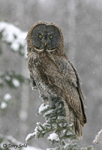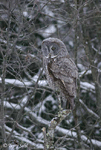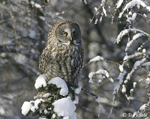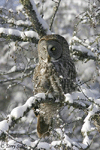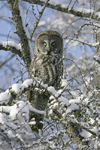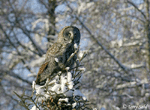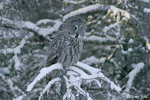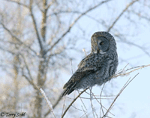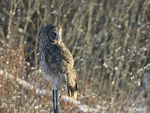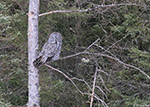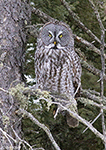| Length: 24 to 33 inches | Wingspan: 54 to 60 inches | Seasonality: Extremely rare winter visitor |
| ID Keys: Distinctive, with very large size, large facial disks, lack of ear tufts, yellow eyes | ||
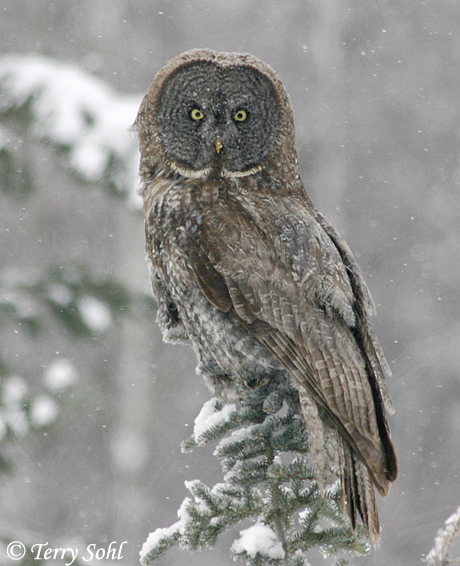 A
bird of northern forests, Great Gray Owls are only an extremely rare winter visitor to the state.
They are one of the largest owls in the state by body size, but body size is
slightly misleading as the species has an extremely thick and dense covering of
feathers. Despite the bird's size, they have relatively weak talons and
primarily prey on small rodents. The only record of the species in South
Dakota upon publication of 1991 edition of
"The Birds of South Dakota" (South Dakota Ornithologist
Union, 1991) was a dead specimen found
in January, 1984
near Dell Rapids (Bradwisch). However, in the winter of 1999,
Vogelmann found a specimen perched on a dead tree stump in his back yard between
Sioux Falls and Brandon. When vole and other small mammal populations
crash in their normal northern haunts, some birds may move southward into parts
of the United States in winter. Large numbers of the species were found in the
Sax-Zim Bog region near Duluth, Minnesota in the winter of 2004/2005, and are
the source of most of the photos found on this page
A
bird of northern forests, Great Gray Owls are only an extremely rare winter visitor to the state.
They are one of the largest owls in the state by body size, but body size is
slightly misleading as the species has an extremely thick and dense covering of
feathers. Despite the bird's size, they have relatively weak talons and
primarily prey on small rodents. The only record of the species in South
Dakota upon publication of 1991 edition of
"The Birds of South Dakota" (South Dakota Ornithologist
Union, 1991) was a dead specimen found
in January, 1984
near Dell Rapids (Bradwisch). However, in the winter of 1999,
Vogelmann found a specimen perched on a dead tree stump in his back yard between
Sioux Falls and Brandon. When vole and other small mammal populations
crash in their normal northern haunts, some birds may move southward into parts
of the United States in winter. Large numbers of the species were found in the
Sax-Zim Bog region near Duluth, Minnesota in the winter of 2004/2005, and are
the source of most of the photos found on this page
Habitat:
Dense conifer forests, adjacent meadows, bogs. Generally prefers mix of dense forest and open areas.
Diet:
Mostly small mammals, including voles, pocket gophers, mice, shrews, squirrels, and weasels.
Behavior:
Great Gray Owls will hunt both during the day and night, with a significant portion of its foraging occurring near dawn or dusk. They can hunt by either sight or sound.
Breeding:
Non-breeder in South Dakota. On their breeding grounds, Great Gray Owls aren't nest builders, instead relying on the use of existing nests of adequate size, most often those built by Common Ravens or various raptor species. They may also sometimes use the broken off top of a tree or on a tree stump, or more rarely, a suitable platform on a human structure. There's no augmentation of an existing nest site, as the female simply lays her 2 to 5 eggs directly on the selected site. The female alone incubates the eggs, but the male will hang around and defend the nest site from intruders. The young hatch after about 30-35 days, and fledge from the nest about another 30-35 days after hatching.
Song:
A bold, deep, booming hoo-hoo-hooo; also utters single-note hoots.
1Click here to hear the typical hooting call of a Great Gray Owl
2Click here to hear the alarm calls of an agitated Great Gray Owl
3Click here to hear the begging calls of a juvenile Great Gray Owl
Migration:
Permanent resident throughout its normal range in Alaska, Canada, higher elevation areas in the western U.S., and northern Minnesota. However, population crashes of prey mammal species sometimes result in numbers of the birds moving southward in winter in search of food.
Interactive eBird Map:
Click here to access an interactive eBird map of Great Gray Owl sightings
Similar Species:
Great Gray Owls are quite distinctive if seen well, if for no other reason than their size. Potentially "confusing" species are listed here primarily because they are the other large owl species that may inhabit the same areas, and could be confused if only seen from a distance or in poor light.
- Barred Owl - Barred Owls have significant overlap in range with Great Gray Owls, and are another large, "tuftless" (ear tufts) owl species that could potentially be confused with a Great Gray Owl, if not seen well. Barred Owls are substantially smaller than a Great Gray Owl on average. Plumage of a Barred Owl appears to have warmer, browner tones than the (surprise!) gray plumage of a Great Gray Owl. Striping on the underparts is cleaner and more distinct on a Barred Owl, compared to the mix of mottling and striping on the underside of a Great Gray Owl. Barred Owls also have dark, seemingly featureless eyes, while Great Gray Owls have yellow eyes.
- Great Horned Owl - Great Horned Owls are found in a vast variety of habitats across North America, with a broad geographic range that completely overlaps that of the Great Gray Owl. Great Horned Owls are smaller than Great Gray Owls on average, but the most noticeable difference are the obvious ear tufts of a Great Horned Owl. Great Horned Owls have yellow eyes like a Great Gray Owl, but they appear to be much larger in proportion to the face than those of a Great Gray (probably due to the nocturnal habits of a Great Horned Owl, while Great Gray Owls are often active during the day). The rich rusty color on the face of a Great Horned Owl also differentiates it from a Great Gray Owl.
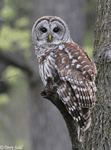 |
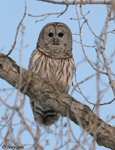 |
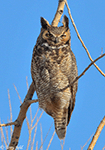 |
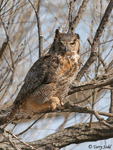 |
| Barred Owl | Barred Owl | Great Horned Owl | Great Horned Owl |
Conservation Status:
Systematic surveys in both the European and North American parts of its range show increasing populations over recent decades. They are found across an extremely broad geographic area in both the Eastern and Western Hemispheres, and have healthy populations in many parts of that range. The IUCN considers the Great Gray Owl to be a species of "Least Concern".
Further Information:
3) Great Gray Owl - Audubon Guide
Photo Information:
December 13th, 2004 - Near Sax-Zim Bog, Minnesota - Terry Sohl
Additional Photos:
Click on the image chips or text links below for additional, higher-resolution Great Gray Owl photos.
Audio File Credits:
1PE Svahn. Recorded in Sweden on April 19th, 2020. Original recording and information available from xeno-canto.
2Lars Edenius. Recorded in Sweden on July 5th, 2018. Original recording and information available from xeno-canto.
2Patrick Aberg. Recorded in Sweden on June 21st, 2017. Original recording and information available from xeno-canto.
| Click on the map below for a higher-resolution view |
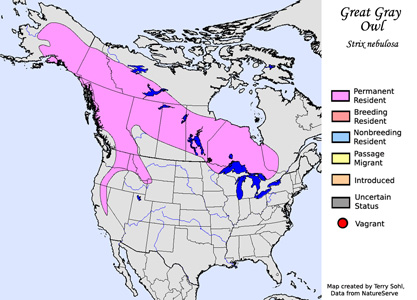 |
| South Dakota Status: Extremely rare winter visitor in South Dakota, with only a handful of records. |
Additional Great Gray Owl Photos
Click for a higher-resolution version of these photos
